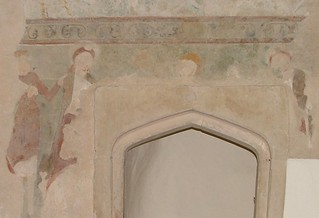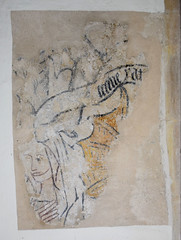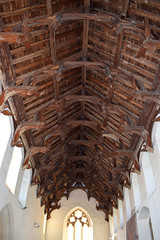Suffolk Churches (original) (raw)
Grundisburgh has one of the prettiest village greens in this part of Suffolk, a small triangle with the church on one side, the former school and an old-fashioned shop on another, and pretty cottages and a good pub along the main road on the third. Two sides of the green are bordered by the infant River Finn, and there is even a ford. An imposing art deco war memorial stands in front of the church, and the curious 1730s tower of Grundisburgh church overlooks it all. Suffolk has several other 18th Century red brick towers, but none are as striking as this one I think, in both its clean lines and imposing presence. James Bettley in the revised Buildings of England volume for Suffolk: East thought that it showed how the Georgians could be every bit as insensitive as the much-maligned Victorians. Edward Hakewill, a local 19th Century architect who was responsible for the 1870s restoration of Grundisburgh church, is said to have wanted to demolish and rebuild the tower in a more familiar Suffolk style, but he died during his work here and the plans were either dropped or the money was not available.
As at a number of churches in the Ipswich area the tower is set against the south wall of the nave, serving a double purpose as the porch. The 18th Century tower replaced a 15th Century one that had been in the same position. The impulse for rebuilding appears to have been to provide a tower for recreational bellringing as with the red brick tower of Drinkstone. A plaque above the south doorway tells us that this steeple was built, the bells set in order and fixt at the charge of Robert Thinge, Gent, lately deceased AD 1731-1732. Grundisburgh has one of Suffolk's few complete rings of twelve bells, and I'm told they are highly thought of.
About halfway up this side is a wide window which gives light to the bellringing chamber. Beneath it is a 19th Century clock to remind us that Tempus Fugit, and the sundial below it, tells us, in Suffolk dialect, that Life pass like a shadow. Eastwards of the tower we are back in medieval Suffolk, the short 14th Century south aisle neat, crenellated and begargoyled. At its eastern end is the chantry chapel of Thomas Wale, built on the eve of the Reformation in 1527, and already demonstrating how an emphasis on secular power was in the ascendant. The dedicatory inscription below the battlements asks us to pray for his soul and that of his wife, but the reliefs show Wale's merchant mark, and the shield of the Salt Merchants' Company, of which he was a member. The high, beautiful clerestory is from half a century earlier, and flushwork monograms punctuate the windows. They include that of St Edmund, what are believed to be the monograms of Thomas and Anne Tudenham who paid for the work, and letters spelling out AVE MARIA.
At the time the tower was rebuilt, the church would still have been decorated with the heavy-handed quotes from scripture that were popular in the late 16th and 17th Centuries.One survives beside the 14th Century south doorway telling us to keep the sabbath and reverence the sanctuary. You step past it into light flooding from the west window, the west end of the nave a wide, clear space since the font on its imposing base was moved to the east end of the south aisle in the early years of the 21st Century. Directly opposite is a striking St Christopher wall painting. it was not uncovered until the 1950s. The Saint's red coat is rich and splendid, and the water he steps through abounds with life. Three fish leap over two courting eels, while five more fish kiss beyond. There is even a mermaid. Buildings stand on either bank, and the fecundity is so infectious that leaved branches are sprouting from the top of the Saint's pilgrim staff. As at Creeting St Peter, there are scroll inscriptions.
Interestingly, the 15th Century clerestory cuts through the head of Christ, a reminder that many wall paintings were whitewashed during a kind of proto-Reformation of the 1400s. At this time, orthodox Catholic doctrine was being asserted by influential families on behalf of the Church in the face of the superstitions and private devotions of the common people. Hence, the erection of bigger and bolder roodscreens, the installation of seven sacrament fonts, and bench ends that depict the sacraments, virtues and vices. Ironically, it was these same influential families who would be championing protestantism a century later, as the secular power within the strong nation state that they had secured eclipsed the cultural reach of the Catholic Church. Perhaps without the magic it no longer gripped their imaginations.
The St Christopher is spectacular, but there are two other wall paintings here of significance. One appears to be the eastern end of a frieze, and is located above the entrance of the roodloft stair doorway in the north wall. It appears to show a man with a nimbus halo being presented by a man with a sword to what seems to be a seated figure. It may show Christ being taken before the Jewish high priest, and thus be part of a passion sequence. It could also conceivably be part of a Saint's martyrdom. Its position is interesting for several reasons. Firstly, it is unlikely to be the final frame in a story, so being at the east end of the north wall it would be at the midpoint of a sequence stretching either clockwise or anti-clockwise around the building. Secondly, it is in a 13th Century style, but has been punched through by a late 14th Century roodloft stairway entrance. What does this suggest? The painting dates from the great artistic flowering which would be cruelly dashed by the Black Death of the late 1340s, when perhaps half the population of East Anglia died. The doorway is cooller, more rational than it would have been half a century earlier.
The final wall painting is a fragment of a Warning against Idle Gossip, a medieval depiction of two women having a chat while saying their rosaries, the devil behind them noting down everything that is said so that it can be used later in evidence against them. It can be found elsewhere in Suffolk at Naughton.
Edward Hakewill's death during the 1870s restoration of the church seems also to have put a stop to his plans for a north aisle, which is as well because we would have lost all the wall paintings for ever. However, he did replace the seating. Those in the nave and aisle are in his functional style familiar from nearby Rushmere St Andrew, but the choir stalls in the chancel retain medieval bench ends, although the figures are Hakewill's replacements. Up above, the nave retains what is considered to be among the best of the smaller double-hammerbeam nave roofs in the county.
Contemporary with the roof are the rood screen and parclose screen, side by side. All three have been restored sensitively since Hakewill's time, the green man in the crocketting to the left of the entrance arch of the rood screen seeming as fresh as if he emerged from the woods yesterday. There are sacred monograms on the panels of the parclose. Above it, the wooden angel corbel of the aisle and the stone shield-bearer corbel of the chapel, a century and a half apart, squat side-by-side.
The restoration of the nave roof is spectacular, more than sixty angels fluttering on the lower and upper hammerbeams, and actually under the spine of the roof itself. How glorious they must have looked in the 15th Century when, full of colour, they hovered together above the people of Grundisburgh. What a vision of heaven that must have been. For centuries they sat in silence, headless and wingless, as part of the protestant project to turn the English into a serious people. Now at last they have taken flight again.
The chancel is a quieter and more sober space than the nave. Up in the roof the medieval crossbeams are still in place. As part of the restoration, Hakewill reset the scattering of medieval glass in the chancel windows. Most of it is decorative, but there are two roundels of flowers, one of which appears to be a Yorkist rose. It may be that the other is also heraldic - could it be an iris? There are also several panels of blue folds, which were probably clothing.
The font that was moved from the western end of the nave to the south aisle is a good example of the typical East Anglian style of the late medieval period, albeit a bit recut. The octagonal bowl has lions interspersed with angels holding shields on its panels. There are more lions on the stem, although the woodwoses that once alternated with them have been recut as buttresses with foliage, presumably because they were so damaged by 16th Century iconoclasts, but also perhaps because the Victorians were uncomfortable about restoring them correctly. A 1517 bequest survives leaving two nobles to the mending of the funte. The base it is set upon isremarkably wide, the sides panelled with openwork quatrefoils which Pevsner dates to Hakewill's restoration although I must say they seem older to me.
The brasses were moved to the wall of the south arcade, presumably as part of Hakewill's restoration. The figures have been lost, presumably to collectors, but the inscriptions survive, and are mounted one above the other. The top two are for families that we have met elsewhere on our travels, and it is fascinating to see them together because they are two of Suffolk's most famous recusant families - that is, those who refused to renounce the old faith at the time of the Reformation. This failure to conform to Anglicanism cost the Sulyards of Haughley Park at Wetherden their estate, but the Mannocks soldiered on at Gifford Hall at Stoke by Nayland, maintaining a Catholic priest throughout the penal years and providing one of Suffolk's first Catholic chapels at Withermarsh Green when Catholicism was at last decriminalised. On the two brasses here, we catch up with the families some two generations after the Reformation The connection between them is that Anne Manocke (died 1610) was the mother-in-law of Thomas Suleyard (died 1612). The Sulyards were particularly loathed by the puritans who seem to have taken a peculiar pleasure in mindlessly defacing the Sulyard memorial at Wetherden. The third brass dates from a century earlier, and is for Thomas and Marjorie Awall.
The big name in the parish in the 18th and 19th Centuries was the Blois family, and their ledger stones pave the chancel, their monuments line the wall. One of the ledger stones gives the date as January 1692/3, a reminder of the time when the new year began on the first Quarter Day, March 25th. In pre-Reformation times this had been the Feast of the Annunciation, but until well into the 18th century it remained the day that financial transactions were marked from, and even now the financial year begins at the start of April, twelve days being lost when England adopted the Julian calendar.
On the wall, there are large Blois monuments to Martha (1645), William (1658) and Charles (1738). Martha's kneelers are full of puritan piety, each with its own character as if drawn from the life. William's memorial is more sober, but Charles's is positively baroque. William was an interesting character. He was a staunch puritan, and a member of the Suffolk Committee for the Prosecution of Scandalous Ministers under the Earl of Manchester. These were the puritan thought police who persecuted theological liberals, sometimes hounding them to their deaths. This might suggest that Grundisburgh was a puritan parish, and perhaps it was by the time he'd finished, but in fact at the start of the Commonwealth period he was responsible for the ejection of Edward Barton, the rector here. Barton was charged with being an absentee minister, only visiting his parish once or twice a year, and he was also charged with having an infirme body & noe audible voice. Liberal priests were usually charged with drunkenness and consorting with prostitutes, of which there seem to have been a good number in 17th Century rural Suffolk, but perhaps Blois felt he had all the evidence he needed here, if Barton was simply genuinely lazy.
Elsewhere in the church are a wooden plaque to Robert Gurdon, killed in the desert in WWII, and a fascinating memorial at the west end of the south aisle to Henry Freeland, who died aged 20 on HMS Royal George near Sweden in 1854. We are told that He died suddenly, but not unprepared, and that it was in the morning of April 25th, off the island of Muskon Where, in the parish churchyard, his remains now lie interred.
Interestingly, I visited here the week of the 150th anniversary of Henry Freeland's death, and apparently the Swedes had made a big thing out of it, There had been a commemorative service on Muskon, and the Rector of Grundisburgh had written something for the memorial programme. The massing of the western European fleets off of Sweden during the Crimean War was the single biggest ever assemblage of warships seen in the Baltic, and Freeland's death became a symbol of the interdependence of England and Sweden, even though he had actually died of an asthma attack, just as his father the rector of neighbouring Hasketon had.








